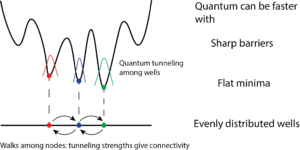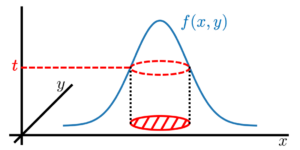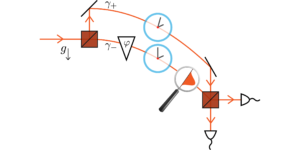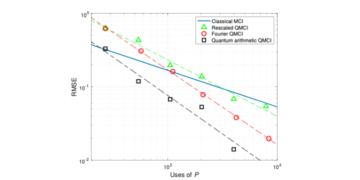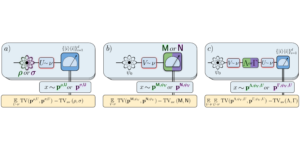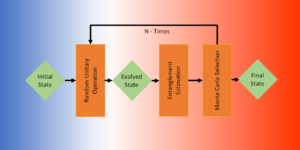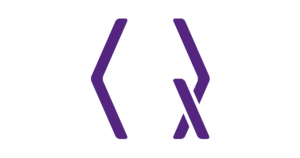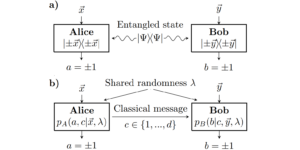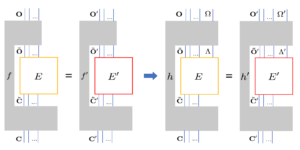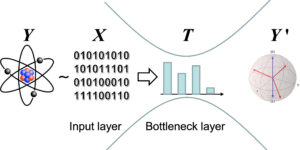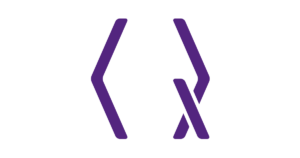1Fachbereich Physik and Dahlem Center for Complex Quantum Systems, Freie Universität Berlin, Arnimallee 14, 14195 Berlin, Germany
2Northeastern University London, Devon House, St Katharine Docks, London, E1W 1LP, United Kingdom
3Khoury College of Computer Sciences, Northeastern University, 440 Huntington Avenue, 202 West Village H Boston, MA 02115, USA
4NIC, DESY Zeuthen, Platanenallee 6, 15738 Zeuthen, Germany
Find this paper interesting or want to discuss? Scite or leave a comment on SciRate.
Abstract
Operator controllability refers to the ability to implement an arbitrary unitary in SU(N) and is a prerequisite for universal quantum computing. Controllability tests can be used in the design of quantum devices to reduce the number of external controls. Their practical use is hampered, however, by the exponential scaling of their numerical effort with the number of qubits. Here, we devise a hybrid quantum-classical algorithm based on a parametrized quantum circuit. We show that controllability is linked to the number of independent parameters, which can be obtained by dimensional expressivity analysis. We exemplify the application of the algorithm to qubit arrays with nearest-neighbour couplings and local controls. Our work provides a systematic approach to the resource-efficient design of quantum chips.
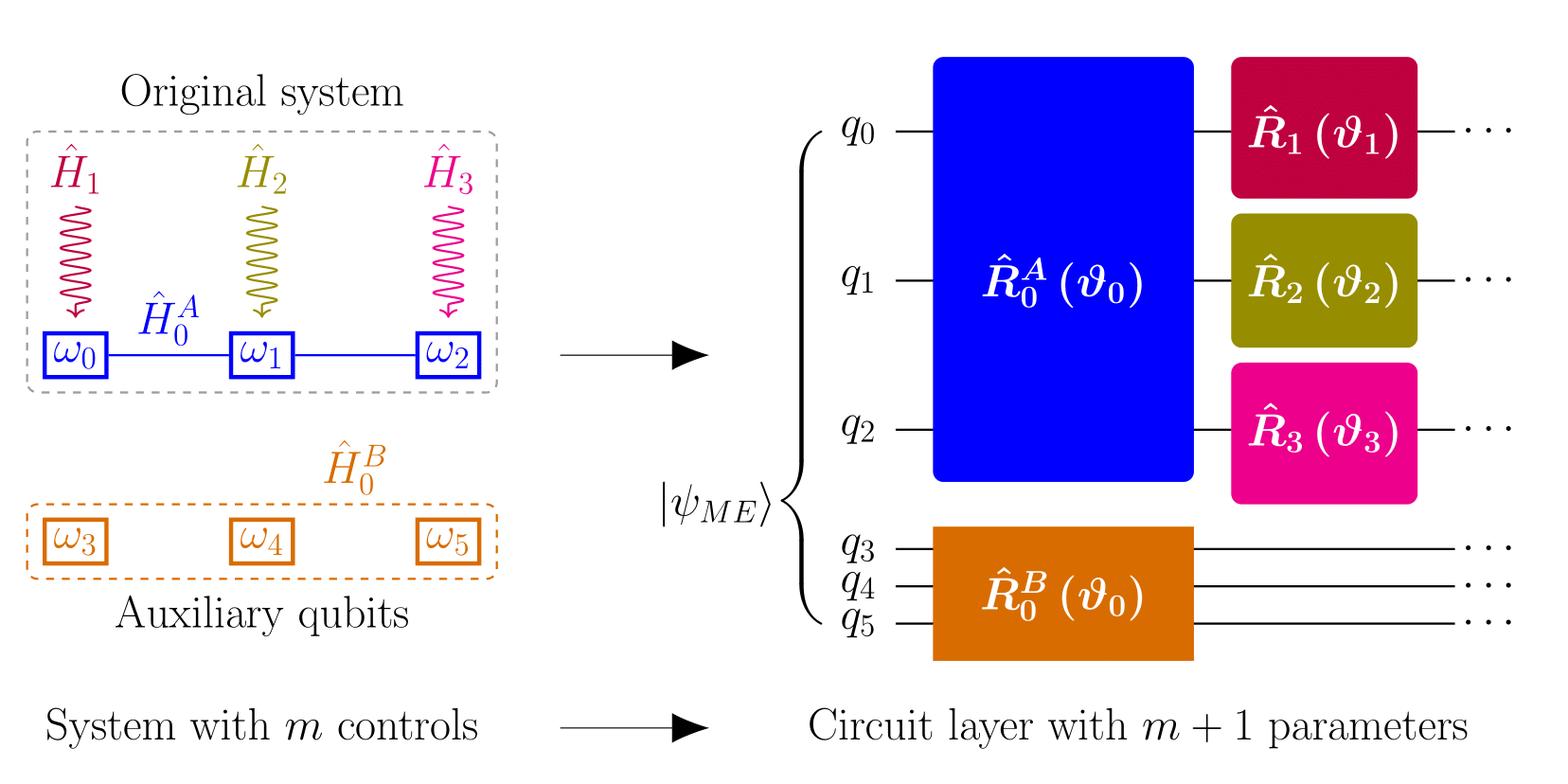
Featured image: Single layer of the parametric quantum circuit designed to test operator controllability on a qubit array with local controls.
Popular summary
Here we present a hybrid quantum-classical test that combines measurements on a quantum device and classical calculations. Our algorithm is based on the concept of parametric quantum circuits, the quantum counterpart of Boolean circuits where some of the logic gates depend on different parameters. We leverage dimensional expressivity analysis to identify all parameters in the circuit that are redundant and can be removed. We show that, for any qubit array, a parametric quantum circuit can be defined such that the number of independent parameters reflects the controllability of the original quantum system.
We hope that this test will provide a useful tool for studying these circuits and for designing controllable quantum devices that can be scaled to larger dimensions.
► BibTeX data
► References
[1] Michael A Nielsen and Isaac L Chuang. ``Quantum computation and quantum information''. Cambridge university press. (2010).
https://doi.org/10.1017/CBO9780511976667
[2] Philip Krantz, Morten Kjaergaard, Fei Yan, Terry P Orlando, Simon Gustavsson, and William D Oliver. ``A quantum engineer's guide to superconducting qubits''. Applied physics reviews 6 (2019).
https://doi.org/10.1063/1.5089550
[3] Juan José García-Ripoll. ``Quantum information and quantum optics with superconducting circuits''. Cambridge University Press. (2022).
https://doi.org/10.1017/9781316779460
[4] Fernando Gago-Encinas, Monika Leibscher, and Christiane Koch. ``Graph test of controllability in qubit arrays: A systematic way to determine the minimum number of external controls''. Quantum Science and Technology 8, 045002 (2023).
https://doi.org/10.1088/2058-9565/ace1a4
[5] Domenico d’Alessandro. ``Introduction to quantum control and dynamics''. CRC press. (2021).
https://doi.org/10.1201/9781003051268
[6] Christiane P. Koch, Ugo Boscain, Tommaso Calarco, Gunther Dirr, Stefan Filipp, Steffen J. Glaser, Ronnie Kosloff, Simone Montangero, Thomas Schulte-Herbrüggen, Dominique Sugny, and Frank K. Wilhelm. ``Quantum optimal control in quantum technologies. strategic report on current status, visions and goals for research in europe''. EPJ Quantum Technol. 9, 19 (2022).
https://doi.org/10.1140/epjqt/s40507-022-00138-x
[7] Steffen J. Glaser, Ugo Boscain, Tommaso Calarco, Christiane P. Koch, Walter Köckenberger, Ronnie Kosloff, Ilya Kuprov, Burkard Luy, Sophie Schirmer, Thomas Schulte-Herbrüggen, D. Sugny, and Frank K. Wilhelm. ``Training Schrödinger’s cat: quantum optimal control. strategic report on current status, visions and goals for research in europe''. EPJ D 69, 279 (2015).
https://doi.org/10.1140/epjd/e2015-60464-1
[8] Francesca Albertini and Domenico D'Alessandro. ``The Lie algebra structure and controllability of spin systems''. Linear Algebra and its Applications 350, 213–235 (2002).
https://doi.org/10.1016/S0024-3795(02)00290-2
[9] U. Boscain, M. Caponigro, T. Chambrion, and M. Sigalotti. ``A weak spectral condition for the controllability of the bilinear Schrödinger equation with application to the control of a rotating planar molecule''. Comm. Math. Phys. 311, 423–455 (2012).
https://doi.org/10.1007/s00220-012-1441-z
[10] Ugo Boscain, Marco Caponigro, and Mario Sigalotti. ``Multi-input Schrödinger equation: controllability, tracking, and application to the quantum angular momentum''. Journal of Differential Equations 256, 3524–3551 (2014).
https://doi.org/10.1016/j.jde.2014.02.004
[11] S. G. Schirmer, H. Fu, and A. I. Solomon. ``Complete controllability of quantum systems''. Phys. Rev. A 63, 063410 (2001).
https://doi.org/10.1103/PhysRevA.63.063410
[12] H Fu, S G Schirmer, and A I Solomon. ``Complete controllability of finite-level quantum systems''. Journal of Physics A: Mathematical and General 34, 1679 (2001).
https://doi.org/10.1088/0305-4470/34/8/313
[13] Claudio Altafini. ``Controllability of quantum mechanical systems by root space decomposition of su(n)''. Journal of Mathematical Physics 43, 2051–2062 (2002).
https://doi.org/10.1063/1.1467611
[14] Eugenio Pozzoli, Monika Leibscher, Mario Sigalotti, Ugo Boscain, and Christiane P. Koch. ``Lie algebra for rotational subsystems of a driven asymmetric top''. J. Phys. A: Math. Theor. 55, 215301 (2022).
https://doi.org/10.1088/1751-8121/ac631d
[15] Thomas Chambrion, Paolo Mason, Mario Sigalotti, and Ugo Boscain. ``Controllability of the discrete-spectrum Schrödinger equation driven by an external field''. Annales de l'Institut Henri Poincaré C 26, 329–349 (2009).
https://doi.org/10.1016/j.anihpc.2008.05.001
[16] Nabile Boussaïd, Marco Caponigro, and Thomas Chambrion. ``Weakly coupled systems in quantum control''. IEEE Trans. Automat. Control 58, 2205–2216 (2013).
https://doi.org/10.1109/TAC.2013.2255948
[17] Monika Leibscher, Eugenio Pozzoli, Cristobal Pérez, Melanie Schnell, Mario Sigalotti, Ugo Boscain, and Christiane P. Koch. ``Full quantum control of enantiomer-selective state transfer in chiral molecules despite degeneracy''. Communications Physics 5, 1–16 (2022).
https://doi.org/10.1038/s42005-022-00883-6
[18] Alberto Peruzzo, Jarrod McClean, Peter Shadbolt, Man-Hong Yung, Xiao-Qi Zhou, Peter J Love, Alán Aspuru-Guzik, and Jeremy L O’brien. ``A variational eigenvalue solver on a photonic quantum processor''. Nature communications 5, 4213 (2014).
https://doi.org/10.1038/ncomms5213
[19] Jarrod R McClean, Jonathan Romero, Ryan Babbush, and Alán Aspuru-Guzik. ``The theory of variational hybrid quantum-classical algorithms''. New Journal of Physics 18, 023023 (2016).
https://doi.org/10.1088/1367-2630/18/2/023023
[20] John Preskill. ``Quantum computing in the nisq era and beyond''. Quantum 2, 79 (2018).
https://doi.org/10.22331/q-2018-08-06-79
[21] Lena Funcke, Tobias Hartung, Karl Jansen, Stefan Kühn, and Paolo Stornati. ``Dimensional expressivity analysis of parametric quantum circuits''. Quantum 5, 422 (2021).
https://doi.org/10.22331/q-2021-03-29-422
[22] Lena Funcke, Tobias Hartung, Karl Jansen, Stefan Kühn, Manuel Schneider, and Paolo Stornati. ``Dimensional expressivity analysis, best-approximation errors, and automated design of parametric quantum circuits'' (2021).
[23] Claudio Altafini. ``Controllability of quantum mechanical systems by root space decomposition of su (n)''. Journal of Mathematical Physics 43, 2051–2062 (2002).
https://doi.org/10.1063/1.1467611
[24] Francesca Albertini and Domenico D'Alessandro. ``Notions of controllability for bilinear multilevel quantum systems''. IEEE Transactions on Automatic Control 48, 1399–1403 (2003).
https://doi.org/10.1109/TAC.2003.815027
[25] SG Schirmer, ICH Pullen, and AI Solomon. ``Identification of dynamical lie algebras for finite-level quantum control systems''. Journal of Physics A: Mathematical and General 35, 2327 (2002).
https://doi.org/10.1088/0305-4470/35/9/319
[26] Marco Cerezo, Andrew Arrasmith, Ryan Babbush, Simon C Benjamin, Suguru Endo, Keisuke Fujii, Jarrod R McClean, Kosuke Mitarai, Xiao Yuan, Lukasz Cincio, et al. ``Variational quantum algorithms''. Nature Reviews Physics 3, 625–644 (2021).
https://doi.org/10.1038/s42254-021-00348-9
[27] Sukin Sim, Peter D Johnson, and Alán Aspuru-Guzik. ``Expressibility and entangling capability of parameterized quantum circuits for hybrid quantum-classical algorithms''. Advanced Quantum Technologies 2, 1900070 (2019).
https://doi.org/10.1002/qute.201900070
[28] Lucas Friedrich and Jonas Maziero. ``The quantum cost function concentration dependency on the parametrization expressivity'' (2023).
https://doi.org/10.1038/s41598-023-37003-5
[29] John M Lee and John M Lee. ``Smooth manifolds''. Springer. (2012).
https://doi.org/10.1007/978-1-4419-9982-5_1
[30] Morten Kjaergaard, Mollie E Schwartz, Jochen Braumüller, Philip Krantz, Joel I-J Wang, Simon Gustavsson, and William D Oliver. ``Superconducting qubits: Current state of play''. Annual Review of Condensed Matter Physics 11, 369–395 (2020).
https://doi.org/10.1146/annurev-conmatphys-031119-050605
[31] Man-Duen Choi. ``Completely positive linear maps on complex matrices''. Linear algebra and its applications 10, 285–290 (1975).
https://doi.org/10.1016/0024-3795(75)90075-0
[32] Andrzej Jamiołkowski. ``Linear transformations which preserve trace and positive semidefiniteness of operators''. Reports on Mathematical Physics 3, 275–278 (1972).
https://doi.org/10.1016/0034-4877(72)90011-0
[33] Seth Lloyd, Masoud Mohseni, and Patrick Rebentrost. ``Quantum principal component analysis''. Nature Physics 10, 631–633 (2014).
https://doi.org/10.1038/nphys3029
[34] Min Jiang, Shunlong Luo, and Shuangshuang Fu. ``Channel-state duality''. Physical Review A 87, 022310 (2013).
https://doi.org/10.1103/PhysRevA.87.022310
[35] Alicia B Magann, Christian Arenz, Matthew D Grace, Tak-San Ho, Robert L Kosut, Jarrod R McClean, Herschel A Rabitz, and Mohan Sarovar. ``From pulses to circuits and back again: A quantum optimal control perspective on variational quantum algorithms''. PRX Quantum 2, 010101 (2021).
https://doi.org/10.1103/PRXQuantum.2.010101
[36] Nicolas Wittler, Federico Roy, Kevin Pack, Max Werninghaus, Anurag Saha Roy, Daniel J. Egger, Stefan Filipp, Frank K. Wilhelm, and Shai Machnes. ``Integrated tool set for control, calibration, and characterization of quantum devices applied to superconducting qubits''. Phys. Rev. Appl. 15, 034080 (2021).
https://doi.org/10.1103/PhysRevApplied.15.034080
[37] Jonathan Z Lu, Rodrigo A Bravo, Kaiying Hou, Gebremedhin A Dagnew, Susanne F Yelin, and Khadijeh Najafi. ``Learning quantum symmetries with interactive quantum-classical variational algorithms'' (2023).
[38] Alicja Dutkiewicz, Thomas E O'Brien, and Thomas Schuster. ``The advantage of quantum control in many-body hamiltonian learning'' (2023).
[39] Rongxin Xia and Sabre Kais. ``Qubit coupled cluster singles and doubles variational quantum eigensolver ansatz for electronic structure calculations''. Quantum Science and Technology 6, 015001 (2020).
https://doi.org/10.1088/2058-9565/abbc74
[40] Abhinav Kandala, Antonio Mezzacapo, Kristan Temme, Maika Takita, Markus Brink, Jerry M Chow, and Jay M Gambetta. ``Hardware-efficient variational quantum eigensolver for small molecules and quantum magnets''. Nature 549, 242–246 (2017).
https://doi.org/10.1038/nature23879
[41] Pauline J Ollitrault, Alexander Miessen, and Ivano Tavernelli. ``Molecular quantum dynamics: A quantum computing perspective''. Accounts of Chemical Research 54, 4229–4238 (2021).
https://doi.org/10.1021/acs.accounts.1c00514
Cited by
Could not fetch Crossref cited-by data during last attempt 2023-12-21 12:25:23: Could not fetch cited-by data for 10.22331/q-2023-12-21-1214 from Crossref. This is normal if the DOI was registered recently. On SAO/NASA ADS no data on citing works was found (last attempt 2023-12-21 12:25:23).
This Paper is published in Quantum under the Creative Commons Attribution 4.0 International (CC BY 4.0) license. Copyright remains with the original copyright holders such as the authors or their institutions.
- SEO Powered Content & PR Distribution. Get Amplified Today.
- PlatoData.Network Vertical Generative Ai. Empower Yourself. Access Here.
- PlatoAiStream. Web3 Intelligence. Knowledge Amplified. Access Here.
- PlatoESG. Carbon, CleanTech, Energy, Environment, Solar, Waste Management. Access Here.
- PlatoHealth. Biotech and Clinical Trials Intelligence. Access Here.
- Source: https://quantum-journal.org/papers/q-2023-12-21-1214/
- :is
- :not
- :where
- ][p
- $UP
- 001
- 1
- 10
- 11
- 12
- 13
- 14
- 15%
- 16
- 17
- 19
- 20
- 2001
- 2008
- 2010
- 2012
- 2013
- 2014
- 2015
- 2016
- 2017
- 2018
- 2019
- 202
- 2020
- 2021
- 2022
- 2023
- 22
- 23
- 24
- 25
- 26
- 27
- 28
- 29
- 30
- 31
- 32
- 33
- 35%
- 350
- 36
- 39
- 40
- 41
- 43
- 54
- 58
- 7
- 72
- 75
- 8
- 87
- 9
- a
- ability
- ABSTRACT
- access
- Accounts
- Achieve
- advanced
- ADvantage
- affiliations
- again
- AI
- AL
- Alexander
- algorithm
- algorithms
- All
- an
- analysis
- and
- Andrew
- Angular
- annual
- any
- Application
- applications
- applied
- approach
- ARE
- Array
- AS
- attempt
- author
- authors
- Automated
- Automatic
- Avenue
- b
- back
- based
- BE
- becomes
- Benjamin
- berlin
- Beyond
- boston
- Bravo
- Break
- brink
- by
- cambridge
- CAN
- capability
- CAT
- Center
- change
- chemical
- Chips
- chow
- christian
- citing
- Cluster
- College
- combines
- comm
- comment
- Commons
- Communications
- complex
- component
- computation
- computer
- computing
- concentration
- concept
- Condensed matter
- condition
- control
- controls
- copyright
- Cost
- could
- Counterpart
- coupled
- CRC
- Current
- Current state
- Daniel
- data
- dec
- defined
- Den
- depend
- Dependency
- Design
- designed
- designing
- designs
- Despite
- Determine
- determining
- device
- Devices
- devise
- different
- dimensions
- discuss
- doubles
- driven
- during
- dynamics
- e
- E&T
- effort
- Electronic
- engineer
- equations
- Era
- Errors
- essential
- Ether (ETH)
- Europe
- Every
- exponential
- external
- Federico
- fei
- few
- field
- Fields
- Find
- For
- found
- frank
- from
- fu
- function
- Gates
- General
- goal
- Goals
- grace
- Grow
- guide
- harvard
- help
- here
- holders
- hope
- House
- However
- HTTPS
- Huntington
- Hybrid
- hybrid quantum-classical
- i
- identify
- IEEE
- if
- image
- implement
- important
- in
- independent
- information
- institutions
- interactive
- interesting
- International
- IT
- ITS
- JavaScript
- joel
- John
- Johnson
- jonathan
- journal
- juan
- karl
- Koch
- larger
- Last
- layer
- learning
- Leave
- Lee
- Leverage
- License
- lie
- linked
- local
- logic
- London
- love
- Magnets
- Maps
- Marco
- Mario
- Mason
- math
- mathematical
- Matter
- matthew
- max
- max-width
- mcclean
- measurements
- mechanical
- melanie
- Michael
- min
- minimum
- molecule
- Momentum
- Month
- Nature
- New
- Nicolas
- no
- Noise
- normal
- Northeastern University
- number
- obtained
- of
- oliver
- on
- open
- operation
- operator
- operators
- optics
- optimal
- or
- original
- Orlando
- our
- Pack
- pages
- Paolo
- Paper
- parameters
- patrick
- perspective
- Peter
- physical
- Physics
- plato
- Plato Data Intelligence
- PlatoData
- Play
- positive
- possible
- potentially
- Practical
- present
- press
- Principal
- Processor
- property
- provide
- provides
- published
- publisher
- Quantum
- quantum algorithms
- quantum computing
- quantum information
- Quantum optics
- quantum systems
- Qubit
- qubits
- R
- realize
- recently
- reduce
- references
- refers
- reflects
- registered
- remains
- Removed
- report
- Reports
- requires
- research
- review
- Reviews
- ROBERT
- root
- roy
- Ryan
- s
- scaling
- Science
- Science and Technology
- SCIENCES
- set
- SG
- show
- SIM
- Simon
- since
- single
- small
- some
- Source
- Space
- Spectral
- Spin
- State
- Status
- stefan
- Strategic
- structure
- Studying
- such
- system
- Systems
- T
- takes
- Technologies
- Technology
- tells
- test
- Testing
- tests
- that
- The
- their
- theory
- These
- this
- time
- Title
- to
- tool
- top
- trace
- Tracking
- trans
- Transactions
- transfer
- transformations
- under
- United
- Universal
- university
- URL
- us
- use
- used
- via
- Village
- visions
- volume
- wang
- want
- was
- Way..
- we
- West
- whether
- which
- will
- william
- with
- Work
- works
- xiao
- year
- Yuan
- zephyrnet

